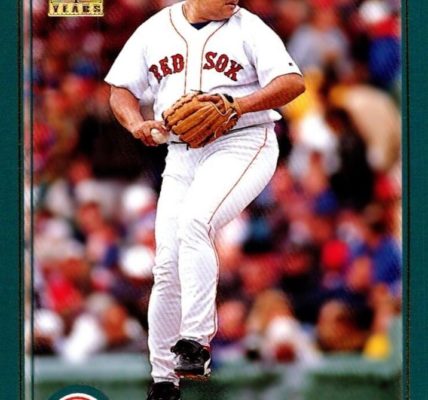Joining Ron Santo in the 2012 Baseball Hall of Fame class, Barry Larkin is enshrined forever in Cooperstown after a nineteen-year Major League Baseball career that spanned from 1986-2004. During that time, he helped the Reds win the 1990 World Series and became the first ever shortstop to hit 30 home runs and steal 30 bases in a season. Larkin also played his entire career in a Cincinnati Reds uniform. As a hitter, he regularly walked more than he struck out, and in the field was a capable shortstop.
Statistically, as far as shortstops go, Larkin stacks up pretty well against his Hall-of-Fame counterparts, with a career line of .295/.371/.444 for an above average OPS of .815 of in over 9000 plate appearances. He didn’t reach any of the major milestones that many Hall of Famers have, such as 3000 hits. But, he did hit 198 home runs (an excellent number for a shortstop) and racked up 379 stolen bases. It’s likely that if Larkin hadn’t missed significant parts of several seasons with injury, his numbers would have finished considerably closer to many of his now peers in the Hall of Fame such as Luis Aparicio and Ozzie Smith.
Larkin Compared to Other Hall of Fame Shortstops
Larkin’s traditional counting statistic totals of hits, home runs, RBI and stolen bases aren’t nearly as “sexy” as those of his Hall of Fame shortstop peers, especially those of Ernie Banks and Cal Ripken Jr. (although Cal played third for the last quarter of his career). Still, Larkin’s numbers are certainly very respectable and notable for any ballplayer, especially one who played nearly two decades of Major League Baseball.
Interestingly enough, however, Larkin actually has a better career OPS (.815) – on-base plus slugging percentage – than Cal Ripken (.787) and one very close to Ernie Banks (.833). Yes, Banks hit over 500 home runs, and Cal certainly was a middle of the order power hitter. Larkin was a prototypical lead-off hitter, and with his high on-base skills and base-running abilities, he produced about the same as those two icons in a somewhat different way.
As far as saber-metric stats like Wins Above Replacement (WAR) are concerned, Larkin racked up 70.5 WAR during his 19-year career according to Baseball Reference. However, FanGraphs pegs Barry Larkin at 67 WAR, thanks to their replacement level being somewhat higher in their calculations. Either way, these are numbers very comparable to Ernie Banks’ 67.7 WAR or defensive wizard Ozzie Smith’s 76.9 WAR, which is predicated on the strength of his glove. FanGraphs has Banks at 63.3 WAR and Smith at 67.6 WAR, respectively.
Cal Ripken’s WAR total is 95.9 by Baseball Reference’s measures and 92.5 by FanGraphs calculations, much higher totals than Larkin, Banks, or Smith. But, he also played in more games than Larkin, hit for more power, and was actually an even slicker fielder (by current fielding metrics) than the career Cincinnati Red. From WAR totals alone, it’s pretty clear that Larkin belongs in the upper tier of Hall of Fame shortstops.
Barry Larkin Compared to the Other Candidates for the Baseball Hall of Fame Class of 2012
Of those that didn’t make the cut for the Hall of Fame induction in 2012, Jeff Bagwell probably should have joined Larkin. Long time workhorse pitcher Jack Morris was not far behind in voting, and nearly joined Barry in Cooperstown. Tim Raines, certainly one of the more underrated players of his time, earned enough votes for another shot at the Hall in 2013. Raines would eventually be inducted in 2017, and Jack Morris would enter in 2018.
Barry Larkin was inducted along with the late Ron Santo, who was elected earlier in 2012 by the Veterans Committee. Of course, Santo passed away several years before, leaving many fans upset that this honor came posthumously. There are many people on both sides of the argument on whether Santo should be in the Hall of Fame or not. But, now that Barry Larkin has entered the Hall along with him, it’s worth seeing how similar he and Santo actually were as ballplayers.
While Santo wasn’t known as a huge offensive player, he played in a pitcher’s era, but still hit 342 home runs and had a well above average OPS of .826, a number very similar to Larkin’s. He also was, like Barry, a good, if not spectacular, defensive infielder (although shortstop is certainly a tougher position to field than third base.) So, if Larkin made it into the Hall, Santo certainly deserves to be there, as well.
Barry Larkin’s Hall of Fame induction was certainly not a huge shock to anyone, simply on the strength of his batting. All of the other candidates had their fair share of doubters, even Bagwell. That’s because Bagwell played during the steroid-fueled era of high offense. Though by all accounts he was clean, he very well could’ve ended up being snubbed a spot in the Hall because of the cheating of his peers. Fortunately, Bagwell would join Larkin in the Hall of Fame in 2017.
So, congratulations to Barry Larkin on a well-deserved induction, a choice which was a fairly easy call.
(Thanks to Baseball Almanac’s list of Hall of Fame Shortstops (pre-Larkin induction) for helping with this fascinating research. I also must thank Fangraphs as always, for their comprehensive player database with all the stats you could ever want. Also, Baseball Reference continues to be the go to source for many things baseball.)








RECENT COMMENTS